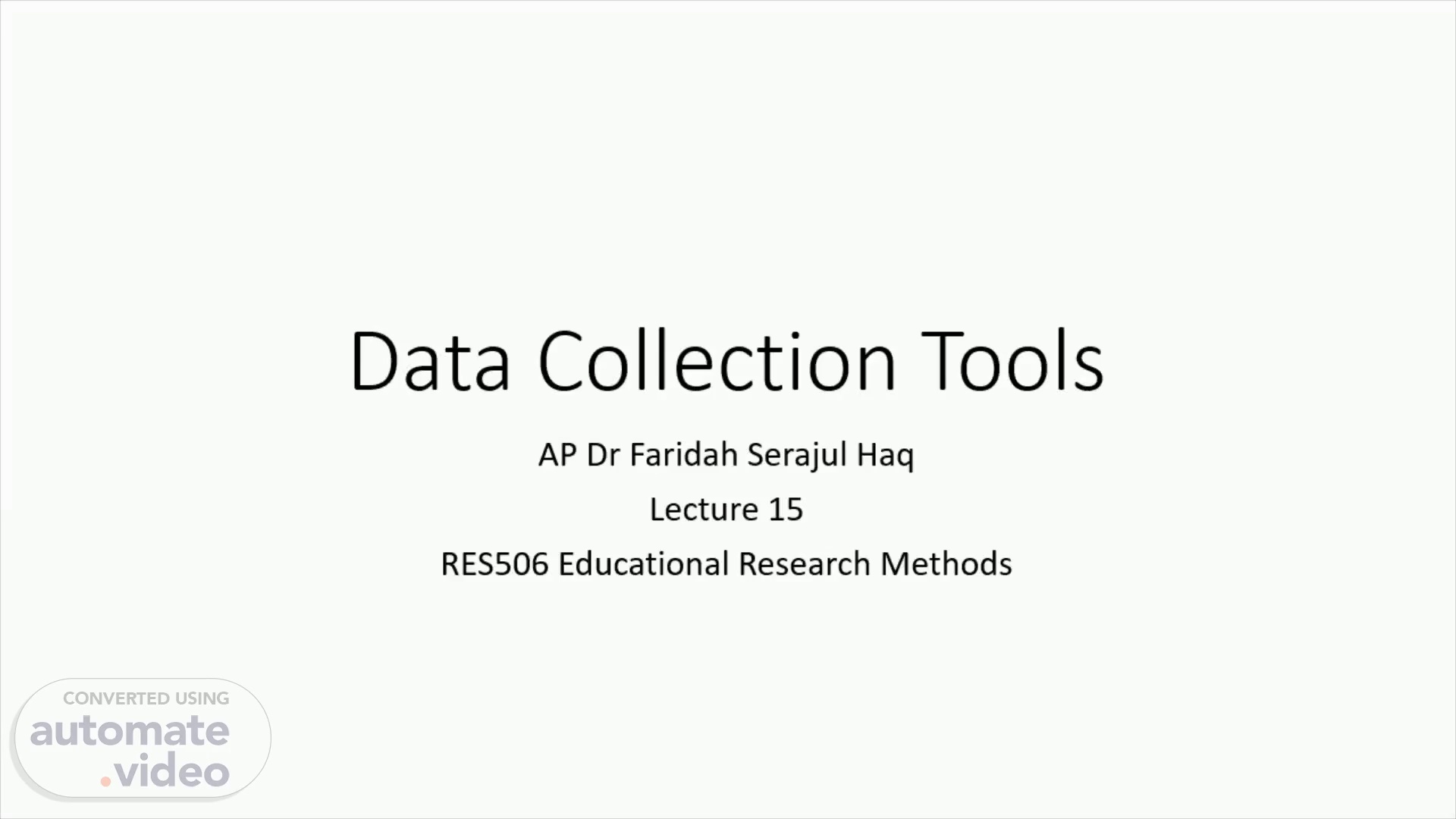
Data Collection Tools
Scene 2 (8s)
Introduction. When choosing the instruments for data collection consider the suitability and criterion of “fitness of purpose” The instruments appropriately selected will ensure useful and usable data are collected.
Scene 3 (20s)
Primary Sources. The questionnaire is a widely used and useful instrument for collecting survey information. It provides structured and numerical data and can be administered without the presence of the researcher It takes time to develop, pilot and refine the questionnaire It has limited flexibility in response Respondents cannot be coerced but encouraged to complete the questionnaire.
Scene 4 (38s)
Survey Questionnaire Ethical Issues. Informed consent Rights to withdraw Benefits of the research Issue of non-maleficence Confidentiality, anonymity and non-traceability Threats or sensitivity Methodological rigor and fairness Reactions of the respondents.
Scene 5 (51s)
Planning of a Questionnaire. Decide on the purposes/objectives of the questionnaire Decide on the population and sample Generate the topics/constructs/concepts/issues to be addressed Decide on the kinds of measures/scales/questions/responses required Write the questionnaire items Check that each issue has been addressed, using several items for each issue Pilot and refine the questionnaire Administer the final questionnaire.
Scene 6 (1m 11s)
Close/Structured Questionnaire. Provides a range of responses from which the respondent may choose Highly structured close questions are useful to generate statistical analysis and comparison among groups Quick to code and directly to the point Categories are not exhaustive Respondents cannot give remarks or explanations.
Scene 7 (1m 27s)
Multiple Choice Questions. Range of choices designed to capture the likely range of responses to a given statement Categories must be discrete, comprehensive, and exhaustive Respondents may interpret the same words differently Prone to problems word order and statement order Respondents scanning the questionnaire may effect the response.
Scene 8 (1m 43s)
Rating Scales. Useful devices for the researcher to build in a degree of sensitivity and differentiation Categories need to be discrete and exhaust the range of possible responses No assumption of equal intervals between categories Numbers have different meanings for different respondents Some rating scales are unbalanced forcing unrealistic choices Respondents are biased towards left hand side of the scale No check on the truthfulness of the responses Tendency of respondents to opt for the mid-point of a 5 or 7 point Likert scale.
Scene 9 (2m 5s)
Semi Structured Questionnaire. Semi-structured questionnaires are an effective method for data collection when the researcher wants: (1) to collect qualitative, open-ended data ; (2) to explore participant thoughts, feelings and beliefs about a particular topic; and (3) to delve deeply into personal and sometimes sensitive issues The questions include: Open-ended questions so that you can get descriptive answers Using language that the respondent can easily understand Using short questions as much as possible Not phrasing questions as negative Asking important questions first..
Scene 10 (2m 28s)
Open/Unstructured Questionnaire. Enables respondents to write a free account in their own terms and to explain/qualify their responses Invites an honest, personal comments from respondents who provide valuable data and information A sentence completion item is useful in an open-ended question Difficulty to convert word-based data to numerical data Respondents may overlook instructions as they focus on the writing tasks.
Scene 11 (2m 47s)
Asking Sensitive Questions. For socially undesirable behaviors Long questions for eliciting information Using familiar words Locate sensitive issue within a discussion Respondents may keep diaries Validate the data.
Scene 12 (2m 59s)
Interviews. The use of interviews is a move away from seeing humans as subjects to be manipulated in research Interviews have a specific purpose and are question-based Interviews are a form of generating information between humans through conversations Interviews are an interchange of views on mutual topics of interest Interviews are flexible tools for data collection enabling the use of multi-sensory channels such as verbal and non-verbal communication Interviews are time-consuming, expensive, and open to bias.
Scene 13 (3m 21s)
Purposes of the Interview. To evaluate/assess a person To select/promote an employee To effect therapeutic change To test/develop hypotheses To gather data To sample respondents’ opinions.
Scene 14 (3m 33s)
Interview Schedules. Refer to the construction of items used in research interviews. It includes: “fixed-alternative” items which offers two alternatives “open-ended” items which gives a frame of reference to the respondents “scale” which is a set of verbal items, each responded by the interviewee indicating degree of agreements or disagreements.
Scene 15 (3m 50s)
Structured Interview. The contents and procedures are organized in advance Sequence and wording of the questions are determined by means of a schedule Interviewer has little freedom to make modifications Characterized by a closed situation.
Scene 16 (4m 3s)
Semi-Structured Interview. Is a qualitative data collection strategy in which the researcher asks the respondents a series of predetermined but open-ended questions Researcher has more control over the interview topics than in unstructured interviews, but unlike structured interviews with closed-ended questions, there is no fixed range of responses to each question. Only source of data for a qualitative research project and is usually scheduled in advance at a specific time and place outside of everyday events Usually organized around a set of predetermined open-ended questions, with additional questions emerging from the dialogue between the interviewer and respondents..
Scene 17 (4m 29s)
Unstructured/Open Interview. Is an open situation having greater flexibility and freedom Content, sequence, and wording of the interview is entirely in the hands of the interviewer Is a more non-directive technique but must be carefully planned according to the purpose of the interview.
Scene 18 (4m 45s)
Conclusion. When choosing to use questionnaires and interviews as your data collection instruments, you as the researcher have to consider the following: Do your participants have the information that your require? Did you pilot the instruments to determine difficult/annoying/personal questions? Are the respondents aware they will have enough time to answer the questions? Are your response categories simple or confusing? Are personal questions asked at the end?.